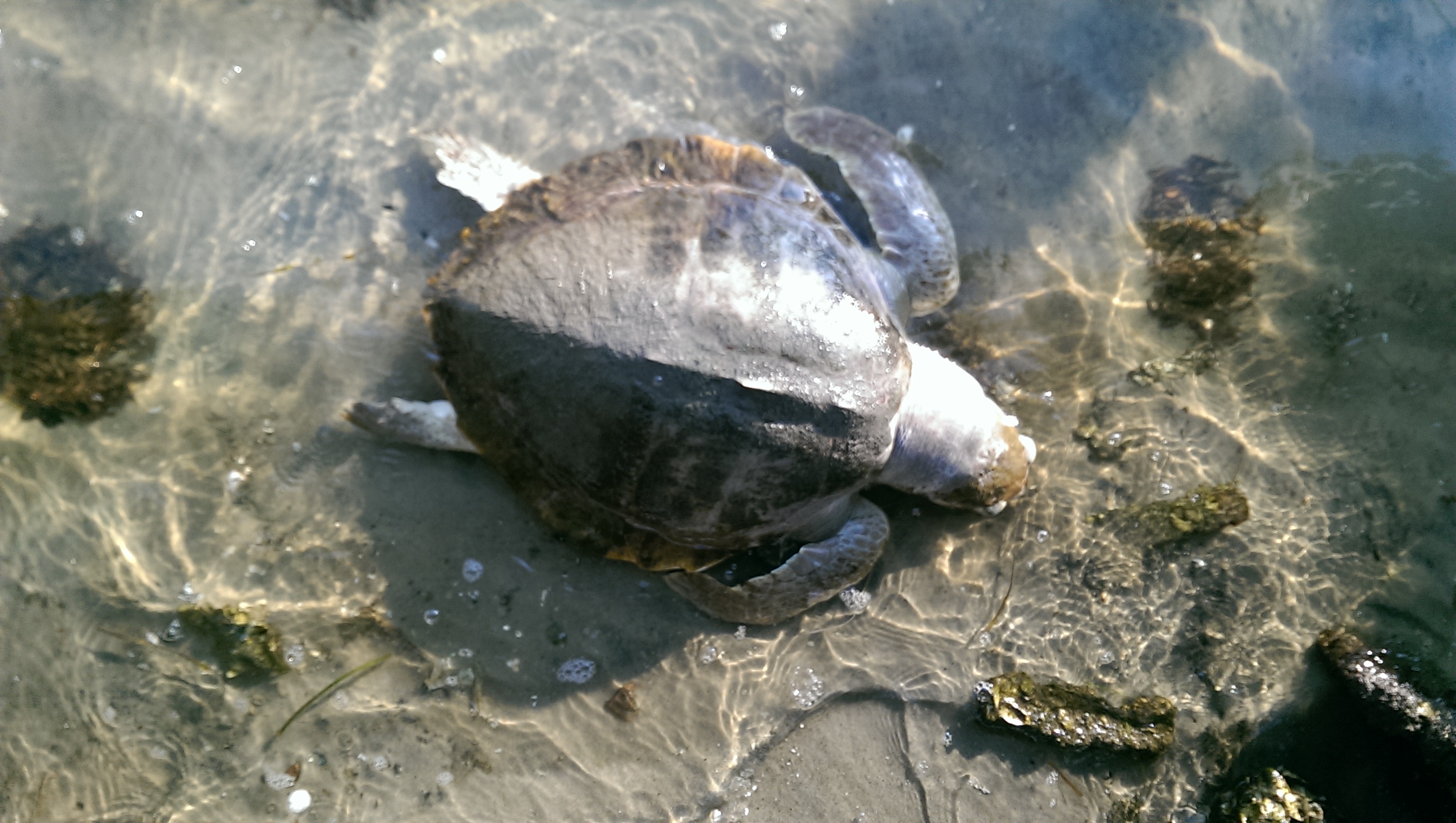
by Rick O'Connor | Feb 2, 2018
Man what a winter!
Between multiple days below freezing, tough traveling, and the flu it has been a brutal winter season so far.
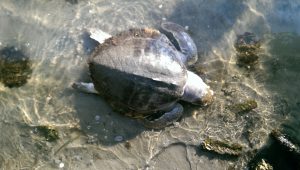
Dead Kemps Ridley Sea Turtle washed ashore in Little Sabine near Pensacola Beach. This turtle died of ingesting monofilament fishing line.
Photo: Betsy Walker
It is not that different for some of our marine wildlife friends. The low temperatures have driven marine water temperatures down as well, particularly in the shallow areas. There have been many reports of cold stunned sea turtles up and down the Florida panhandle – over 900 of them. There have been reports of cold stunned iguanas falling from trees and the loss of pythons in south Florida. The question sometimes comes up – “how do they deal with this apparent return from the dead?”
One has to remember we are dealing with reptiles – cold-blooded creatures. Actually, the more correct term is poikilothermic. It really does not pertain to the temperature of their blood but their core body temperature in general. Some animals, like humans, can maintain a constant body temperature, like 98.6°F, no matter what the environmental temperatures are – these are referred to as homotherms. Heterotherms can allow their body temperatures fluctuate within a range – but are in control of their body temperatures. The poikilotherms cannot control their body temperature and are thus at the mercy of the environment – the classic “cold blood”. Some of these poikilotherms have been known to actually freeze and thaw – with no observable problems, not so much for our “warm blooded” friends.
So what’s up with the cold-stunned situation?
Well… even with the “cold bloods”, extreme temperature changes can be very stressful. Some respond by changing their behavior, others their physiology, others both. They will alter their feeding – basically stop. In some, the pH and ion balance within their blood becomes unbalanced, which can trigger the feeding reduction response and increase ion exchange within the lungs. The partial pressure within the venous blood can decrease and this, along with the chemical imbalance and feeding reduction, can trigger a “lethargic” response and even a “floating” response in the marine turtles.
Locally, it seems to be the sea turtles who are having the most problems. In south Florida, scientists have noticed the American Crocodile and the invasive pythons struggle with these cold temperatures but the wider ranged American Alligator and numerous species of native snakes do not. The “locals” seem to alter their behavior to adjust for these extreme temperature drops – a method that the tropical species are not practicing. It is known that certain native freshwater turtles over winter in frozen ponds, and diamondback terrapins are known to “hunker down” in muddy bottoms of salt marsh creeks when water temperatures drop below 59°F.
With sea turtles, the larger migratory individuals offshore are still moving at 43°F but is the smaller inshore juveniles that are the subject of stunning events. The water temperatures change more rapidly in shallower water and at 43°F, these smaller sea turtles become lethargic and float – which increases their chance of predation. Data suggest that Green Sea Turtles begin to slow activity and Kemps Ridleys become more agitated when water temperatures drop below 68°F, both become dormant, reduce feeding and breathing when they drop below 59°F. It is believed the real problems from being cold stunned are from the reduction of food as much, if not more than, the actual temperature itself. The “cold bloods” bask to increase their body temperatures so that they can actually digest their food.
It is a problem frequently encountered along the American east coast but not as much in Florida. However, this year has been different. The staff and volunteers from government agencies and local aquaria have done a champion job rescuing and rehabilitating many of these animals.
References
Mazzotti, F. J., M. S. Cherkiss, M. Parry, J. Beauchamp, M. Rochford, B. Smith, K. Hart, and L. A. Brandt. 2016. Large reptiles and cold temperatures: do extreme cold spells set distributional limits for tropical reptiles in Florida? Ecosphere 7(8):e01439. 10.1002/ecs2.1439
Moon D.Y., D.S. MacKenzie, D.W. Owens. 1997. Simulated Hibernation of Sea Turtles in the Laboratory: I. Feeding, Breathing Frequency, Blood PH, and Blood Gases. The Journal of Experimental Zoology. 278: pp. 362-380.
Milton, S.A., P.L. Lutz. 2003. The Biology of Sea Turtles, Volume II. Edited P.L. Lutz, J.A. Musick, J. Wyneken. CRC Press. Pp. 510.

by Rick O'Connor | Jan 19, 2018
In the last article, we discussed what phytoplankton are, what their needs were, and their importance to marine life throughout the Gulf and coastal estuaries. In this article, we will discuss the different types of phytoplankton found in our waters.
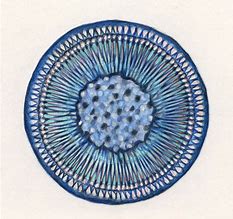
The spherical shape of the centric diatom.
Image: Florida International University
Marine scientists interested in the diversity and abundance of phytoplankton will typically sample using a plankton net. There are a variety of different shapes and sizes of these nets, but the basic design would be funnel shaped with a sample jar attached at the small end of the funnel. The plankton net would be towed behind the research vessel at varying depths for a set period of time. All plankton collected would be analyzed via a microscope. According to the text Identifying Marine Phytoplankton (1997) there are at least 14,000 species of phytoplankton and some suggest as many as 120,000. Most of these, 12,000-100,000, are diatoms, one of five classes of marine phytoplankton. The majority of the phytoplankton fall into one of two class, the diatoms and the dinoflagellates.
Diatoms are typically single celled algae encased in a clear silica shell called a frustule. The frustule can come in a variety of shapes, with or without spines, and many resemble snowflakes – their quite beautiful. They are found in the bay and Gulf in great numbers, as many as 40,000,000 cells / cup of seawater. They are the dominate phytoplankton in colder waters and are most abundant near upwellings. These are the “grasses of the sea” and the base of many marine food webs. When diatoms die, their silica shells sink to the seafloor forming layers of diatomaceous earth, which is used in filters for aquariums and oxygen mask in hospitals.
Dinoflagellates differ from diatoms in that they produce two flagella, small hair-like projections from the algae that are used for generating water currents and movement. Their shells are not silica but layers of membranes and are called thecas. Some membranes are empty and others contain different types of polysaccharides. Dinoflagellates are more abundant than diatoms in warmer waters. There are about 2000 species of them. One type, Noctiluca, are responsible for what locals call “phosphorus” or bioluminescence. These dinoflagellates produce a blue-ish light when disturbed. Many see this when walking the beach at night. Their footprints glow for a few seconds. At night, boaters can see this as their prop wash turns the dinoflagellates in the water column. The bioluminescence is more pronounced in the warm summer months and is believed to be defense against predation. The light is referred to as “cool” light in that the majority of the energy is used in producing light, not lost as heat as with typical incandescent bulbs – hence the birth of the LED light industry.
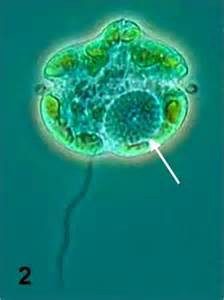
The dinoflagellate Karenia brevis.
Photo: Smithsonian Marine Station-Ft. Pierce FL
Several dinoflagellates produce toxins as a defense. Some generate what we call red tides. In the Gulf of Mexico, Karenia brevis is the species most responsible for red tide. Red tides typical form offshore and are blown into coastal areas via wind and currents. They are common off the coast of southwest Florida but occur occasionally in the panhandle. Many local red tides are actually formed in southwest Florida and pushed northward via currents. Red tides are known to kill marine mammals and fish, as well as closing areas for shellfish harvesting.
Like true plants, phytoplankton conduct photosynthesis. Between the diatoms and dinoflagellates, 50% of the planet’s oxygen is produced. These are truly important players in the ecology of both the open Gulf and local bays.
References
Annett, A.L., D.S. Carson, X. Crosta, A. Clarke, R.S. Ganeshram. 2010. Seasonal Progression of Diatom
Assemblages in Surface Waters of Ryder Bay, Antarctica. Polar Biology vol 33. Pp. 13-29.
Hasle, G.R., E.E. Syvertsen. 1997. Identifying Marine Phytoplankton. Academic Press Harcourt Brace and
Company. San Diego CA. edited by C.R. Tomas. Pp. 858.
Steidinger, K.A., K. Tangen. 1997. Identifying Marine Phytoplankton. Academic Press Harcourt Brace and
Company. San Diego CA. edited by C.R. Tomas. Pp. 858.

by Rick O'Connor | Jan 5, 2018
Last year I began a series of articles on the Gulf of Mexico. They focused on the physical Gulf – water, currents, and the ocean floor. This year the articles will focus on the life within the Gulf, and there is a lot of it.
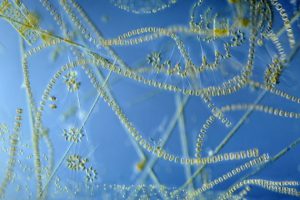
Single celled algae are the “grasses of the sea” and provide the base of most marine food chains.
Photo: University of New Hampshire
We will begin with the base of food web systems, the simplest creatures in the sea. The base of food systems are generally plants and the simplest of these are the single celled plants. Singled celled plants are a form of algae, not true plants in the sense we think of them, but serving the same role in the environment – which is the production of much needed energy.
What these single celled algae need to survive is the same as the more commonly known plants – sunlight, water, carbon dioxide, oxygen, and nutrients.
Sunlight is difficult for marine plants because sunlight only penetrates so deep. Therefore, marine plants and algae must live in shallow water, or have some mechanism to remain near the surface in the open sea. In relation to their overall body volume, smaller creatures have more surface area than larger ones. More surface area helps resist sinking and the smallest you can get is a single cell. Thus, most marine algae are single celled. Many single celled plants are encased in transparent shells that have spines and other adaptations to assist in increasing their surface area and keeping them near the surface. Some actually have drops of oil (buoyant in water) making it even easier to stay near the surface. These small floating algae drift in the surface currents, and drifting organisms are called plankton. Plankton that are “plant-like” are called phytoplankton.
The next needed resource is water; the Gulf and Bay are full of it. However, saltwater is not what they need – freshwater is, so they must desalinate the water before absorbing it. They can do this by adjusting the solutes within their cytoplasm. The greater the ratio of surface area is to volume, the more diffusion of solutes can take place – thus these small phytoplankton are very good at diffusing resources in (like water and carbon dioxide) and expelling waste (like ammonia and oxygen).
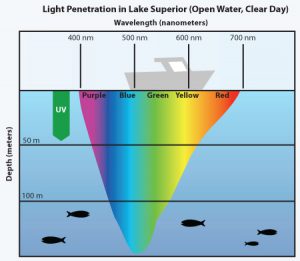
Image showing how deep different colors of light penetrates in the sea.
Image: Minnesota Sea Grant
Carbon dioxide and oxygen are dissolved in seawater and, like water, are diffused into the phytoplankton. Warmer water holds less oxygen so there would be a tendency to have more phytoplankton in colder waters. However, warmer waters are so because there is generally more sunlight, a needed resource. The colder, sunlit, surface waters off some coasts – such as California – have higher amounts of dissolved oxygen and are some of the most productive areas in the ocean. Phytoplankton can also serve as “carbon sinks” by removing carbon dioxide dissolved in the seawater coming from the atmosphere. However, this may not be the answer to excessive CO2 in the atmosphere because, like all creatures, you can only consume so much “food”. Excessive loads of carbon dioxide will not be consumed.
Finally, there is the need for nutrients. All plants need fertilizer. Nutrients in the sea come from either run-off from land, or decayed material from the ocean floor. Much of the nutrients are discharged into the Gulf by run-off from land. Because of this, much of the phytoplankton are congregated nearshore where rivers meet the sea. We think of marine life as equally distributed across the ocean, but in act it is not, there is more life nearshore. For the compost on the ocean floor to be of used by phytoplankton, it must reach the surface. This happens where a current called an upwelling occurs. Upwellings rise from the seafloor bringing with them the nutrients. Where upwellings occur, the seawater is colder, and sunlight abundant, you have the greatest concentration of marine life – all fueled by these phytoplankton.
In the Gulf, one of the most productive places is “the plume”, where the Mississippi River discharges. This massive river brings water, sediments, and nutrients, from most of the continent. The large plankton blooms attract massive schools of plankton consuming fish, predatory fish, sea birds, and marine mammals.
In the next post, we discuss some of the different phytoplankton that inhabit our coastal waters and the amazing things they do.
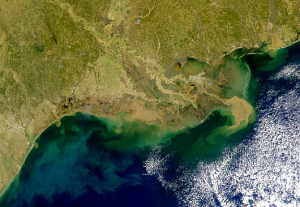
A satellite image showing the sediment plume of the Mississippi River. This plume brings with it nutrients that fuel plankton blooms.
Image: NASA satellite
References
Kirst G.O. (1996) Osmotic Adjustment in Phytoplankton and MacroAlgae. In: Kiene R.P., Visscher P.T.,
Keller M.D., Kirst G.O. (eds) Biological and Environmental Chemistry of DMSP and Related Sulfonium Compounds. Springer, Boston, MA

by Rick O'Connor | Dec 15, 2017
2017 began as most years do, the Bermuda high slid east across the Atlantic Ocean and the cold fronts began to reach the Gulf Coast. However, this past winter was milder than normal. Either the high did not slide as far east as it typically does, or the fronts did not pack the punch they normally do – but we did not have as many deep freezes in 2017. That’s how it began.
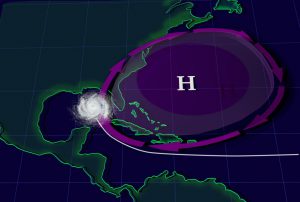
The Bermuda High influences both our weather and climate in the Florida panhandle.
Image: Goddard Media NASA
As spring approached the Bermuda High made its’ annual move westward, bringing us the clockwise winds from the southeast and moisture from the Gulf. It was time for rain… and rain it did. It rained and rained and rained. It rained so much that the salinities in the local bayous in Pensacola, which typically run between 10-15 parts per thousands, were below 1 ppt – freshwater. These heavy rains triggered high bacteria counts in the water column, which triggered health advisories – increasing 139% this year.
Late spring and summer is the season of afternoon thunderstorms – and Sea Grants’ estuary monitoring programs in Pensacola Bay. This year we observed many things:
- Numerous bald eagles, more than we had seen before
- Communities calling about snake encounters – this is not unusual when it rains, but this year there were more venomous snakes than we typically see.
- We began to get calls concerning Cuban Anoles (an invasive lizard) all along the coast from Perdido Key to Gulf Breeze. As more people searched, more anoles were found. I saw the first two at my house this year.
- We were searching for horseshoe crabs, and found them! In several locations in the lower bay, but never found where they were nesting – we will continue to search in 2018.
- Our terrapin surveys extended to Walton County. We found two new terrapin nesting beaches in Escambia and the sea turtle nests reached record numbers across the state.
- Our scallop surveys in Santa Rosa Sound and Big Lagoon were a complete bust due to the rain. Either it was raining, or the visibility was so poor you could not see. An algal bloom occurred in St. Joe Bay that closed scalloping for most of the season.
- We began a seagrass monitoring project with the University of West Florida. This was a tough year to begin due to the poor visibility, but we will continue in 2018.
- Manatee sightings were reported in Big Lagoon and Santa Rosa Sound. Again, this is not that unusual but the number of sightings, the number of manatees together, and the length of time they remained in the bay were.
- And then the mangroves – nine red mangroves were reported in Big Lagoon. Sea Grant will be working with Dauphin Island Sea Lab and resource managers from NERRS in Florida, Alabama and Mississippi to search for more mangroves in the northern Gulf in 2018.
- And the rain continued…
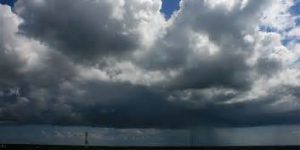
Rain storms are common when the Bermuda High is in the western Atlantic.
Photo: Stuart Health, NOAA
As summer moves into fall the Bermuda High typically begins to slide eastward, taking with it the “protection” from summer hurricanes – and the hurricanes came. First, it was Harvey, then Irma, then Maria, and then Nate. All had their impacts on the area.
- First were the flamingos in Pensacola, three of them, photographed in different locations around the bay – then they were gone.
- Numerous flocks of white pelicans. They typically fly through the area but there appeared to be more than we normally see and reports of them landing across the area increased.
- We received calls about “invasive” plants growing in the bayou – which turned out to be freshwater plants that had taken advantage of the freshwater conditions in our bayous from the heavy rains.
- The snake encounters did not decrease
- The mangroves continued to grow
- The manatee sightings continued into the fall
- And the rain continued
How did this season fare with local seafood (Escambia County only)?
- There was a 17% decrease in the number of species harvested – from 59 to 49
- And an 11% decrease in the price/lb. fishers received for their seafood – from $2.20/lb. to $1.95/lb.
- But there was a 33% increase in the pounds of seafood reported – from 839,673 to 1,121,225 lbs.
- A 38% increase in the number of trips reported – from 2,658 to 3,664 trips
- And a 25% increase in the estimated value of the local seafood harvest – from $1,589,518 to $1,991,286 – vermillion snapper, red snapper, and striped mullet remain our top three target species.
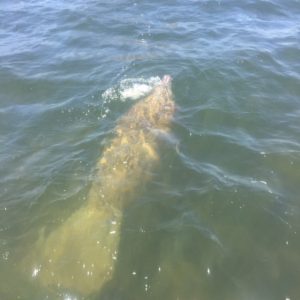
Manatee swimming in Big Lagoon near Pensacola.
Photo: Marsha Stanton
We are now moving into winter. The Bermuda High has moved across the Atlantic. This typically begins a dry season – and it has been dry for several weeks. It also allows cold fronts to reach the coast – and they did. On December 9, it snowed in Pensacola. Who knows what 2018 will bring but we will continue to be in the field monitoring and observing. There are opportunities for locals to volunteer for some of our monitoring projects, and there are other agencies and NGOs in the area seeking volunteers for monitoring and restoration projects. Join us if you like, and have a very happy holiday season.

by Rick O'Connor | Dec 8, 2017
The observations I made of rattlesnakes is just that… observations, there is no scientific study I am aware that supports what I appear to have seen, but I have noticed it – more than once now.
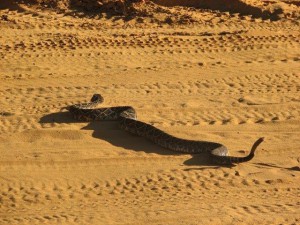
Eastern Diamondback Rattlesnake crossing road at Eglin AFB. Photo: Carrie Stevenson
The eastern diamondback rattlesnake (Crotalus adamanteus) is a legendary animal in the southeast United States. William Bartram mentions it several times during his travels through Florida in the 1770’s. His Florida nickname “Pug Puggy” actually came from an incident where he killed a large one in a garden of a Seminole camp. Almost every story about the colonial/settling period of state, whether fiction or non-fiction, includes this snake. They are the largest venomous snake in the U.S., reaching up to six feet, and can have the girth of a man’s arm. They have a large head, holding large venom glands, and have a strike range of 33% their body length – the stuff of legends.
However, few people of died from this animal. One website list 53 fatal snakebites in the United States since 1900, 11 are listed “prior to 1900”. Of the 53 snakebites, 34 (64%) were from rattlesnakes – all 11 (100%) of the “prior to 1900” were rattlesnakes. However, there are a reported 16 species of rattlesnakes in the U.S., only three live in the southeast. From this list, there are only three confirmed Eastern Diamondback bites (5%), and an additional 7 that “may” have been. They were identified as rattlesnakes and the victims lived in the southeast, but the bite could have been from the timber or pygmy rattlesnake. The vast majority of lethal rattlesnake bites come from out west. Granted, in the early part of our state’s history many rattlesnake bites went unreported, however 3 confirmed deaths (10 possible) since we became a state is not that many when compared to the number of Floridians who have died in automobile accidents or violent crimes. That said, this is still a legendary animal that many fear, and the snake lives on Pensacola Beach.
In the past month, I have received several photographs of the eastern diamondback seen in the National Seashore. The observation – they seem to be more common when we are not around. No doubt, they were probably once common on the island. Many are surprised by this because the only way to access Santa Rosa Island, initially, was to swim – but rattlesnakes are good swimmers. They do not prefer the water, but have no problem crossing it. They are primarily consumers of rodents, taken prey as large as rabbits if they can, and hunt primarily at night – so viewing during the day is not common.
However, when the road to Pickens was closed after Hurricane Ivan, daytime encounters with eastern diamondbacks increased. There were numerous reports of individuals seeing them moving around the park. Then the road re-opened, and no one saw them anymore. Hurricane Nate caused enough damage that the park, once again, had to close for repairs – and the photos began to come in. It will be interesting to see if the number of encounters begins to decline no that it has re-opened. Are these snakes aware of our presence and seek refuge? It would be nice to know they did, but both Ivan and Nate arrived in the fall when rattlesnakes begin to move for breeding. How many of these snakes would be seen whether the road was open or not. I know when the road is open I do not hear as much from the public. I also know that recently FWC was requesting reports of encounters with this snake because they feared it was declining across the state. Along with several other species of local snakes – such as the Southern Hognose (Heterodon simus) and the Florida Pine Snake (Pituophis melanolucas migitus), they were asking the public to report sightings. They recent removed the eastern diamondback from this list – suggesting that encounters were more common than they thought. Again, maybe a case of “I’m here but I’m hiding”.
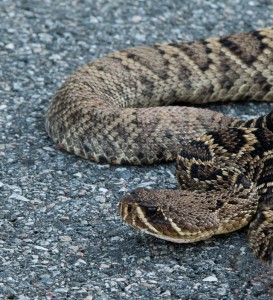
The familiar face of an Eastern Diamondback Rattlesnake.
Photo: Nick Baldwin
For me, it is an interesting observation. I find the animal fascinating, maybe because of its legendary status and rare encounters, but I find it fascinating nonetheless. I certainly understand the safety concerns with having this animal so close to us, but the records of bites and fatalities suggests the threat is not as large as we perceive it. I would certainly recommend homeowners maintain their property as to reduce the risk of an encounter, but know most do – or else you would be seeing more of them. As with sharks, I for one am glad to know they are still around.
















